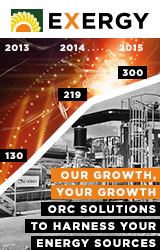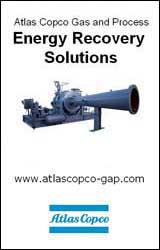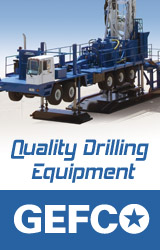Tapping into Mine Water Geothermal
Unused waste product is a useful resource
 Mine water is often considered not only a waste, but also a serious danger to human and environmental health. With millions of miles of abandoned tunnels in the United States filled with potentially acidic and heavy metal enriched water, the task of cleaning it up is daunting. However, this expensive hazard can also be a profitable resource.
Mine water is often considered not only a waste, but also a serious danger to human and environmental health. With millions of miles of abandoned tunnels in the United States filled with potentially acidic and heavy metal enriched water, the task of cleaning it up is daunting. However, this expensive hazard can also be a profitable resource.
Communities around the world have tapped into mine water reservoirs for geothermal heating and cooling. But to date, there are fewer than 30 existing systems, despite mine water’s prevalence. One is at the Keweenaw Research Center just north of Houghton, Michigan.
In Michigan’s Keweenaw Peninsula, a legacy of copper mining—long since boomed and busted—is being reworked into a geothermal and alternative energy future. Researchers and students at Michigan Technological University and Keweenaw Research Center have established an interdisciplinary team to manage an active mine water geothermal system, refine its mechanics and develop community outreach materials.
Collaboration is key
Michigan Tech graduate student Edward Louie spearheaded the project as part of his master’s work in energy policy, and put together a guideline for communities across the country interested in mine water geothermal projects.
Locally, Louie and other student researchers collaborated with the village of Calumet to assess the extensive mine tunnel network under the town. In a place that gets more than an average of 200 inches of snow every year, using geothermal for heat is important.
A lot of heat can be drawn from mine water without it cooling down, because the mine water in the Keweenaw stays around 53°F to 55°F. These year-round temperatures can then be used to heat or cool buildings using simple technology, standard in most geothermal systems, but the key is having a good heat pump.
Heat pumps - an old technology for a modern application
“A heat pump is simply a device that can move and concentrate heat with relatively little energy input,” Louie says, adding the equipment has been around since the 1970s. “The efficiency of heat pumps are has gotten better, their reliability has gotten better, but the technology itself is not from Star Trek.”
In a geothermal heating system, the heat pump concentrates a relatively small amount of heat from the mine water, which remains much warmer than the winter outside air, into comfortable temperatures for heating a building. For cooling, the heat pump works in reverse, dumping cooler air into the building. And for every unit of energy used to power the heat pump to do this exchange, the pump can move four, and sometimes more, units of heat.
Geothermal systems are inherently flexible, depending on location and the quality of the mine water. In the Keweenaw, where pure copper was dug up, the mine water is relatively clean. In other areas, mine water laden with heavy metals and acid, which corrodes equipment. That makes implementing the systems challenging, but not impossible. Louie and his team outline several open- and closed-loop systems in the mine water geothermal guidebook.
Closed-loop systems help protect equipment from corrosive mine water by exchanging heat outside a loop of corrosion resistant pipes placed inside the mineshaft. The mine water itself is never pushed through the heat pumps. At the Keweenaw Research Center, they pipe the mine water up from 300 feet below the surface, an open-loop system. Through a big heat exchanger, the mine water cools or heats a closed-loop system within the building.
“It’s just like the radiator in your car,” says Jay Meldrum, the director of the Keweenaw Research Center. “Only the heat from the mine shaft water is what we are using.”
Within the building loop, a water-glycol mix circulates and runs through 18 heat pumps throughout the center’s main building. The heat from the mineshaft water acts as a pre-heater to bring the temperature of the refrigerant up to the mineshaft temperature, approximately 55°F. The higher the temperature the more performance we get out of the heat pump.
“We hope to use geothermal as an educational resource,” Meldrum says, adding they’re working with the National Park Service to install an exhibit in the Calumet Visitor Center. “It’s also an area we want to continue doing research in.”
Cost is always a concern
One challenge is the double-whammy of high electric prices and cheap natural gas in the region. Chris Green, who directly manages the Keweenaw Research Center’s mine water geothermal system, also points out that while it’s a cleaner technology, it is still dependent on electricity. Green hopes to combine solar and mine water geothermal to make the system more carbon neutral, but the problem is the large initial investment required. In an economically depressed area like the Keweenaw Peninsula, the only green most people seem to care about is in their wallets.
Still, with some of the nation’s highest electricity rates—second only to Hawaii—the appeal of solar is big, and geothermal is competitive with propane and fuel oil heating, which are fairly common in the region.
With so few active systems in the world, the Keweenaw Research Center is a unique resource for people living in the region. Tapping into the mine water is also a tribute to the area’s history, says Richelle Winkler, a community and environmental sociologist at Michigan Tech who works with the Keweenaw Research Center crew.
“Using the mine water for geothermal energy creates an opportunity to recast community identity,” Winkler says. “Which both celebrates the mining heritage, and promotes progress forward in an environmentally sustainable way.”
With so much room for expansion, the Keweenaw could become a hub for mine water geothermal. And through the guidebook, Winkler and her collaborators could help shape a widespread environmental problem into a solution and resource.
Waste product to useful energy
The guidebook project was funded by a People, Prosperity and Planet (P3) grant through the Environmental Protection Agency (EPA). The student researchers on the project, spanning fields from mechanical energy, policy, chemistry, and communications, presented their work in Washington DC this April. They received an honorable mention, plus won a special award for having the most interdisciplinary and community engaged work and will be presenting at the American Institute of Chemical Engineers conference in November.
For him, Green says the success of the project so far comes from turning a waste product into a useful system. He also says it fits into the current ideal of locally produced energy.
“Everyone used to generate their own power—how do we return to that?” he asks. “This mine water is just sitting below the surface and it’s an unused resource. We can change that.”
 Allison Mills is a rock and dance geek, working as a science writer at Michigan Tech, and occasional freelancer for EARTH Magazine.
Allison Mills is a rock and dance geek, working as a science writer at Michigan Tech, and occasional freelancer for EARTH Magazine. Volume: September/October 2015











